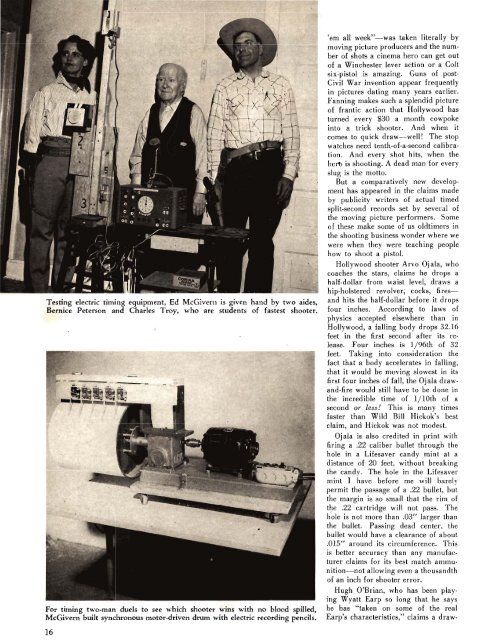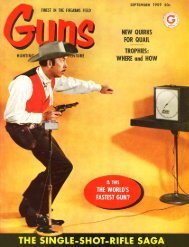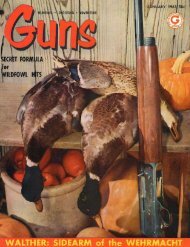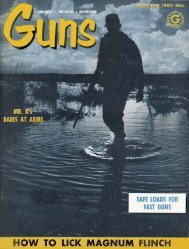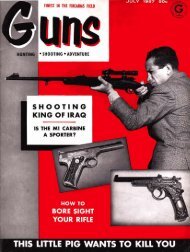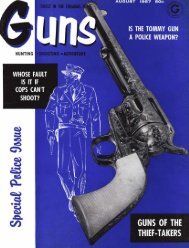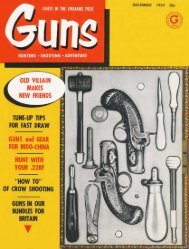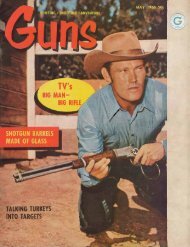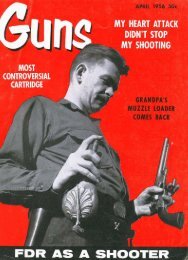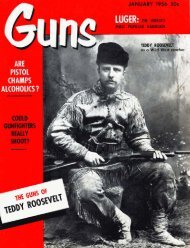Create successful ePaper yourself
Turn your PDF publications into a flip-book with our unique Google optimized e-Paper software.
Testing electric timing equipment, Ed McGivern is given hand by two aides,<br />
Bernice, Peterson and Charles Troy, who are students of fastest shooter.<br />
Â¥ "-<br />
^: -<br />
I<br />
For timiig two-man duels to see which shooter wins with no blood spilled,<br />
McGivern built synchronous motordriven drum with electric recording pencils.<br />
'em all week"-was taken literally by<br />
moving picture producers and the num-<br />
ber of shots a cinema hero can get out<br />
of a Winchester lever action or a Colt<br />
six-pistol is amazing. Guns of post-<br />
Civil War invention appear frequently<br />
in pictures dating many years earlier.<br />
Fanning makes such a splendid picture<br />
of frantic action that Hollywood has<br />
turned every $30 a month cowpoke<br />
into a trick shooter. And when it<br />
comes to quick draw-well! The stop<br />
watches need tenth-of-a-second calibra-<br />
tion. And every shot hits, when the<br />
hem is shooting. A dead man for every<br />
slug is the motto.<br />
But a comparatively new develop-<br />
ment has appeared in the claims made<br />
by publicity writers of actual timed<br />
split-second records set by several of<br />
the moving picture performers. Some<br />
of these make some of us oldtimers in<br />
the shooting business wonder where we<br />
were when they were teaching people<br />
how to shoot a pistol.<br />
Hollywood shooter Arvo Ojala, who<br />
coaches the stars, claims he drops a<br />
half-dollar from waist level, draws a<br />
hip-holstered revolver; cocks, fires-<br />
and hits the half-dollar before it drops<br />
four inches. According to laws of<br />
physics accepted elsewhere than in<br />
Hollywood, a falling body drops 32.16<br />
feet in the first second after its re-<br />
lease. Four inches is l/96th of 32<br />
feet. Taking into consideration the<br />
fact that a body accelerates in falling,<br />
that it would be moving slowest in its<br />
first four inches of fall, the Ojala draw-<br />
and-fire would still have to be done in<br />
the incredible time of l/lOth of a<br />
second or less! This is many times<br />
faster than Wild Bill Hickok's best<br />
claim, and Hickok was not modest.<br />
Ojala is also credited in print with<br />
firing a .22 caliber bullet through the<br />
hole in a Lifesaver candy mint at a<br />
distance of 20 feet, without breaking<br />
the candy. The hole in the Lifesaver<br />
mint I have before me will barely<br />
permit the passage of a .22 bullet, but<br />
the margin is so small that the rim of<br />
the .22 cartridge will not pass. The<br />
hole is not more than .03" larger than<br />
the bullet. Passing dead center, the<br />
bullet would have a clearance of about<br />
.015" around its circumference. This<br />
is better accuracy than any manufac-<br />
turer claims for its best match ammu-<br />
nition-not allowing even a thousandth<br />
of an inch for shooter error.<br />
Hugh O'Brian, who has been play-<br />
ing Wyatt Earp so long that he says<br />
he has "taken on some of the real<br />
Earp's characteristics," claims a draw-


